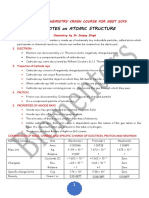0% found this document useful (0 votes)
22 views3 pagesStructure of Atom Class11 Notes
The document provides an overview of the structure of the atom, including the discovery of subatomic particles such as electrons, protons, and neutrons. It discusses various atomic models, including Thomson's plum pudding model, Rutherford's nuclear model, and Bohr's model, along with their limitations and the quantum mechanical model. Key concepts such as quantum numbers, shapes of orbitals, and electronic configuration principles are also summarized.
Uploaded by
dy2654niceCopyright
© © All Rights Reserved
We take content rights seriously. If you suspect this is your content, claim it here.
Available Formats
Download as PDF, TXT or read online on Scribd
0% found this document useful (0 votes)
22 views3 pagesStructure of Atom Class11 Notes
The document provides an overview of the structure of the atom, including the discovery of subatomic particles such as electrons, protons, and neutrons. It discusses various atomic models, including Thomson's plum pudding model, Rutherford's nuclear model, and Bohr's model, along with their limitations and the quantum mechanical model. Key concepts such as quantum numbers, shapes of orbitals, and electronic configuration principles are also summarized.
Uploaded by
dy2654niceCopyright
© © All Rights Reserved
We take content rights seriously. If you suspect this is your content, claim it here.
Available Formats
Download as PDF, TXT or read online on Scribd
/ 3




















































